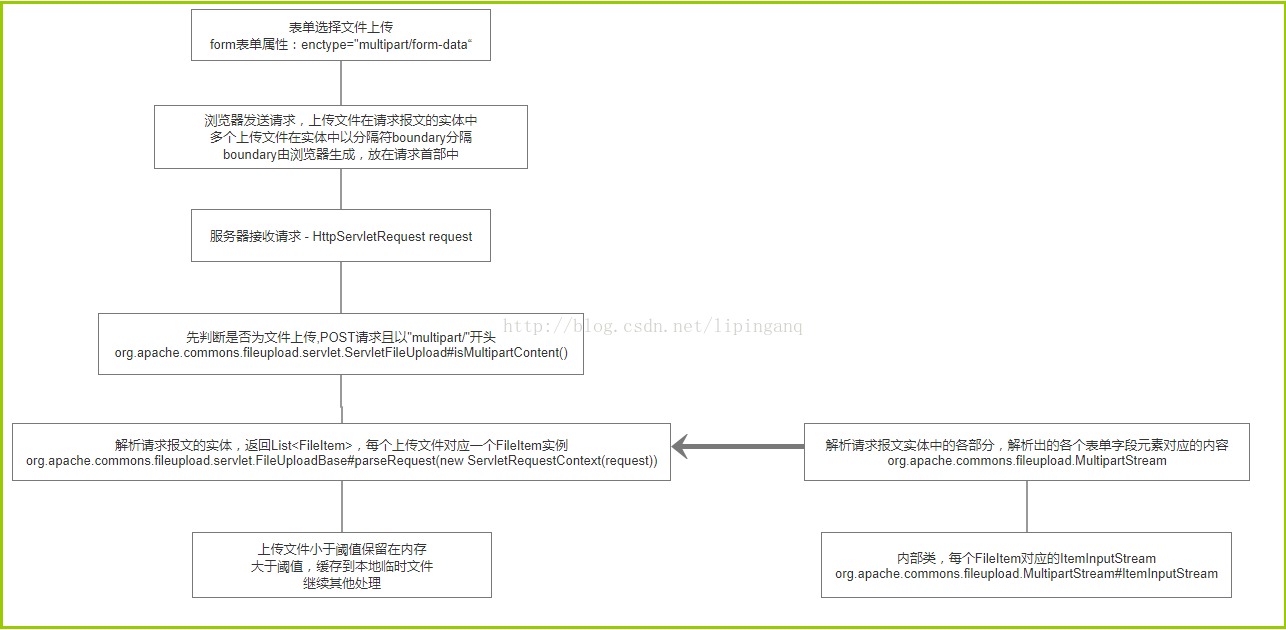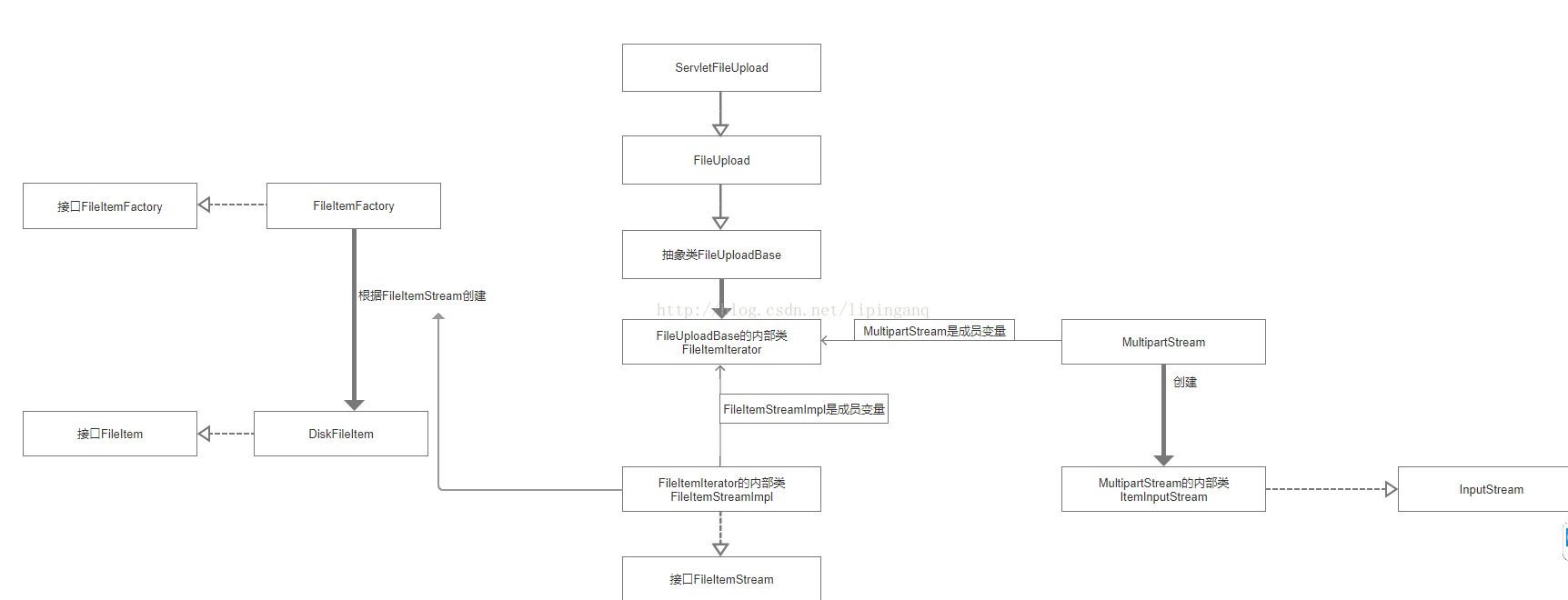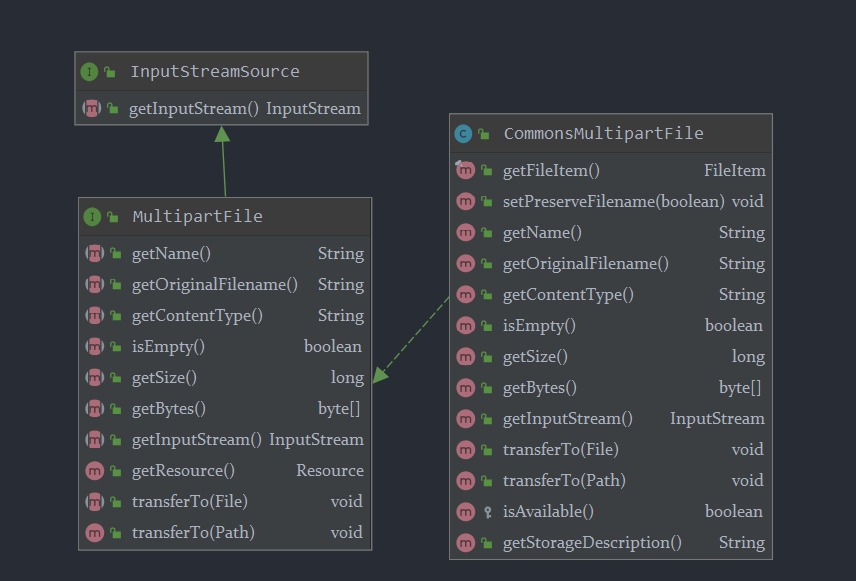java常用API -FILE+MapStruct
2021-03-02 22:29
标签:转换 api 缓存 垃圾回收 ril autowire throws blog director 默认的FileItemFactory实现 参考文档 1)uese:外部引入的转换类; 2)componentModel:就是依赖注入,类似于在spring的servie层用@servie注入,那么在其他地方可以使用@Autowired取到值。该属性可取的值为 a)默认:这个就是经常使用的 xxxMapper.INSTANCE.xxx; b)cdi:使用该属性,则在其他地方可以使用@Inject取到值; c)spring:使用该属性,则在其他地方可以使用@Autowired取到值; d)jsr330/Singleton:使用者两个属性,可以再其他地方使用@Inject取到值; 1.2、@Mappings——一组映射关系,值为一个数组,元素为@Mapping 1.3、@Mapping——一对映射关系 1)target:目标属性,赋值的过程是把“源属性”赋值给“目标属性”; 2)source:源属性,赋值的过程是把“源属性”赋值给“目标属性”; 3)dateFormat:用于源属性是Date,转化为String; 4)numberFormat:用户数值类型与String类型之间的转化; 5)constant:不管源属性,直接将“目标属性”置为常亮; 6)expression:使用表达式进行属性之间的转化; 7)ignore:忽略某个属性的赋值; 8)qualifiedByName:根据自定义的方法进行赋值; 9)defaultValue:默认值; 1.4、@MappingTarget——用在方法参数的前面。使用此注解,源对象同时也会作为目标对象,用于更新。 1.5、@InheritConfiguration——指定映射方法 1.6、@InheritInverseConfiguration——表示方法继承相应的反向方法的反向配置 1.7、@Named——定义类/方法的名称 注意:实体类必须具有完整的all args构造函数,使用@builder注解后将丢失全构造函数 注意:使用自定义转换器时,mapstruct无法自动反序列识别,必须手动指定 java常用API -FILE+MapStruct 标签:转换 api 缓存 垃圾回收 ril autowire throws blog director 原文地址:https://www.cnblogs.com/WheelCode/p/14400253.htmljava常用API -FILE+MapStruct
FILE
文件上传原理解析

FileItem解析

DiskFileItemFactory解析
3.1 大小阈值为10KB
3.2 Repository是系统默认的临时目录,由其返回:System.getProperty("java.io.tmpdir")
4.1 当临时文件不在需要时,临时文件会自动删除(更确切的说:当java.io.File对应的实例被垃圾回收时)
4.2 清理这些临时文件是由一个FileCleaningTracker实例和一个相关的线程完成的
4.3 在复杂的环境中,例如在Web应用程序中,您应该考虑终止此线程,例如,当您的Web应用程序结束时。// get temporarily store files
public File getRepository() {
return repository;
}
// set directory used to temproarily store files
public void setRepository(File repository) {
this.repository = repository;
}
使用example
// transfer file to multipart
public static MultipartFile transferFileToMultiPartFile(File file) throws IOException {
String defaultFileName = "file";
String contentType = getContentType(file);
FileItem fileItem = new DiskFileItemFactory().createItem(defaultFileName, contentType, true, file.getName());
FileInputStream inputStream = new FileInputStream(file);
OutputStream outputStream = fileItem.getOutputStream();
// copy file content to fileItem
IOUtils.copy(inputStream,outputStream);
return new CommonsMultipartFile(fileItem);
}
// get ContentType
public static String getContentType(File file) throws IOException {
Path path = Paths.get(file.getAbsolutePath());
return Files.probeContentType(path);
}
//overload method
public static MultipartFile transferFileToMultiPartFile(String fileName) throws IOException {
File file = FileUtils.getFile(fileName);
return transferFileToMultiPartFile(file);
}

note: 从NativeWebRequest获取multipart
MultipartHttpServletRequest multipartRequest = (MultipartHttpServletRequest) nativeWebRequest.getNativeRequest(HttpServletRequest.class);
// 这里必须获取requestparam 且指定参数必须一致
MultipartFile file = multipartRequest.getFiles("file").get(0);
note1:在断点处获取请求信息
((ServletRequestAttributes)RequestContextHolder.getRequestAttributes()).getRequest().getHeader("token")MapStruct
使用example
实体类
@Data
@NoArgsConstructor
@AllArgsConstructor
@Builder
public class Test1Vo {
private String name;
private String password;
private Integer count;
private Double money;
private String createTime;
}
@Data
@NoArgsConstructor
@AllArgsConstructor
@Builder
public class Test2Vo {
private String username;
private String passwd;
private Integer NewCount;
private Integer NewMoney;
// mapStruct 转换与这两个注解无关
@JsonFormat(pattern = "yyyy-MM-dd HH:mm:ss")
@DateTimeFormat(pattern = "yyyy-MM-dd HH:mm:ss")
private LocalDateTime createTime;
}
MapStructInterface
@Mapper(uses = {testMap.class})
public interface TestVoTransfer {
TestVoTransfer INSTANCE = Mappers.getMapper(TestVoTransfer.class);
@Mappings({
@Mapping(source = "username", target = "name",qualifiedByName = "Test2NameToTest1Name"),
@Mapping(source = "passwd", target = "password"),
@Mapping(source = "newCount", target = "count"),
@Mapping(source = "newMoney", target = "money", qualifiedByName = "ConvertMoney"),
@Mapping(source = "createTime",target = "createTime", dateFormat = "yyyy-MM-dd HH:mm:ss")
})
Test1Vo toTest1Vo(Test2Vo test2Vo);
@InheritInverseConfiguration
@Mappings({
@Mapping(source = "name",target = "username",qualifiedByName = "Test1NameToTest2Name")
})
Test2Vo toTest2Vo(Test1Vo test1Vo);
// 自动转换
ListMapMain
public static void main(String[] args) {
Test2Vo test2Vo = Test2Vo.builder().username("username").passwd("123456")
.NewCount(22).NewMoney(12).createTime(LocalDateTime.now()).build();
Test1Vo test1Vo = TestVoTransfer.INSTANCE.toTest1Vo(test2Vo);
String test1Json = ToStringBuilder.reflectionToString(test1Vo, ToStringStyle.JSON_STYLE);
System.out.println("test1:" + test1Json);
Test2Vo test2Vo1 = TestVoTransfer.INSTANCE.toTest2Vo(test1Vo);
String test2Json = ToStringBuilder.reflectionToString(test2Vo1, ToStringStyle.JSON_STYLE);
System.out.println("test2:" + test2Json);
ArrayListtestMap
@Component
public class testMap {
@Named("Test2NameToTest1Name")
public static String UserNameMap(String inputValue){
// key Test2 name / value test1Vo name
Mapfinally 生成的实体类
@Generated(
value = "org.mapstruct.ap.MappingProcessor",
date = "2021-02-13T15:31:44+0800",
comments = "version: 1.2.0.Final, compiler: javac, environment: Java 1.8.0_121 (Oracle Corporation)"
)
public class TestVoTransferImpl implements TestVoTransfer {
@Override
public Test1Vo toTest1Vo(Test2Vo test2Vo) {
if ( test2Vo == null ) {
return null;
}
Test1Vo test1Vo = new Test1Vo();
test1Vo.setName( testMap.UserNameMap( test2Vo.getUsername() ) );
test1Vo.setCount( test2Vo.getNewCount() );
test1Vo.setPassword( test2Vo.getPasswd() );
if ( test2Vo.getNewMoney() != null ) {
test1Vo.setMoney( test2Vo.getNewMoney().doubleValue() );
}
if ( test2Vo.getCreateTime() != null ) {
test1Vo.setCreateTime( DateTimeFormatter.ofPattern( "yyyy-MM-dd HH:mm:ss" ).format( test2Vo.getCreateTime() ) );
}
return test1Vo;
}
@Override
public Test2Vo toTest2Vo(Test1Vo test1Vo) {
if ( test1Vo == null ) {
return null;
}
Test2Vo test2Vo = new Test2Vo();
test2Vo.setNewCount( test1Vo.getCount() );
test2Vo.setPasswd( test1Vo.getPassword() );
if ( test1Vo.getCreateTime() != null ) {
test2Vo.setCreateTime( java.time.LocalDateTime.parse( test1Vo.getCreateTime(), DateTimeFormatter.ofPattern( "yyyy-MM-dd HH:mm:ss" ) ) );
}
test2Vo.setNewMoney( ConvertMoney( test1Vo.getMoney() ) );
test2Vo.setUsername( testMap.transferName( test1Vo.getName() ) );
return test2Vo;
}
@Override
public List
上一篇:初识Java